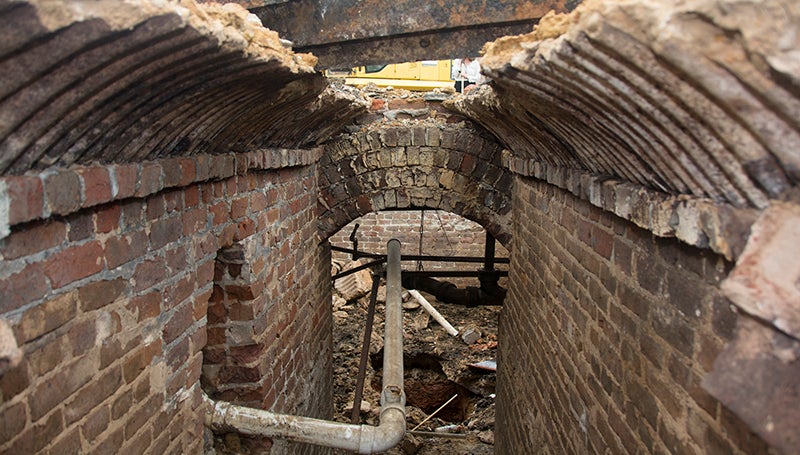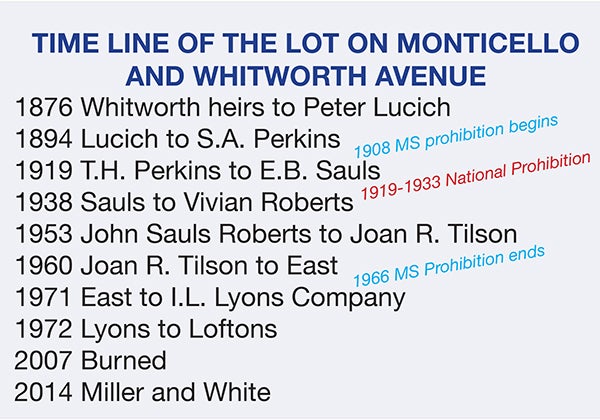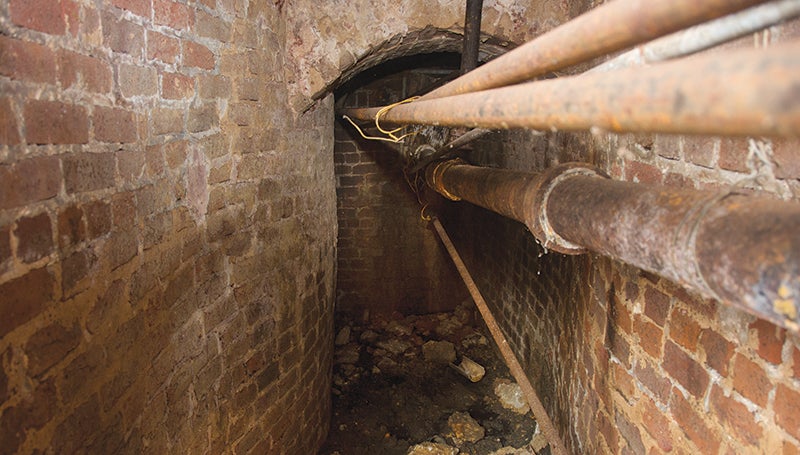Unearthing hidden history: Stories surface about city’s underground
Published 10:15 pm Saturday, July 5, 2014

DAILY LEADER / KATIE WILLIAMSON / An arch is above the entry way into the small brick room discovered under the lot where the new Miller & White accounting office is being built at the corner of Monticello Street and Whitworth Avenue.
When construction crews broke ground on a new Miller & White accounting office that is being built in the lot on the corner of Monticello Street and Whitworth Avenue downtown, they unearthed a mystery from one of Brookhaven’s past lives: a small brick room with steps and a small space that leads to a door in the sidewalk.
Since the discovery, speculation has run rampant, but a deeper look in to the lot’s past has illuminated an interesting chapter of Brookhaven’s history.
The earliest records available at the Lincoln-Brookhaven Government complex show that the lot was sold to Peter Lucich by the Whitworth heirs in 1876. Lucich built the two-story St. Marco hotel on the lot. This is the first recorded building and most likely the only building that was on the property.
John Perkins, whose family bought the property from Lucich, said The St. Marco hotel was a layover place for railroad crews who liked to drink and enjoyed the company of nightly female companions.
According to Perkins, the hotel resembled buildings in downtown New Orleans. It had a balcony with intricate iron railings. Several current Brookhaven residents recounted the same tale about a man that was so drunk that he fell off that balcony and died. Brookhaven was not a place you would bring your children to in those days, the story goes. 
There are two predictions about the original use for the underground room. Some say that it was used for shoveling in coal for steam heat and some say it was used for storing water in case of a fire.
If it was for steam heat, the little door on the sidewalk could have been used for transporting coal to the boiler, which would have been used to heat the hotel. Coal heat was very messy, so when natural gas was available, people abandoned the older-style fuel as soon as possible. Around the 1920s, coal heat was obsolete in the area. The little room would have been abandoned in the early 1900s, leaving it available for all kinds of mischief, according to local stories
On the other hand, the space may have been built to store water. Firefighters would use the water that was kept under buildings as the only means of putting out fire, some say. The room would have housed a kind of cistern that firemen could pump water from. This method of firefighting was used way before the Lucich building existed, but it could explain the hole in the floor of the room.
In both scenarios, the little brick belowground room was established at the same time as the hotel in 1876.
In 1894 the Perkins family bought the building from Lucich. The property was the site of the first Perkins furniture, which later moved to the building across the street.
The history of the building gets a bit complicated from this point, because the original property was divided among different business owners. It is speculated that the small brick room may have resided on the north half of the property, so the rest of the stories primarily follows the north part of the lot.
When Perkins sold his property to Sauls in 1919, the building contained Star Lunch, A.C. Cato and Merchants and Farmers Bank, according to government records. Old copies of The Daily Leader report that in 1899 Gus Bell opened a shop in the building and in 1900 Dr. Gordon Penn located his dentistry practice in an apartment in the Lucich building and Mr. Day opened a barbershop.
National prohibition was put into effect in 1919. During this time, drinking became an underground activity marked by moonshiners and speakeasies. This period ended nationally in 1933.
Most local residents’ speculations about the underground room revolve around a moonshiner’s keep. John Perkins said it was definitely used for liquor, although he never took a drink down there.
“Things were a lot looser back then,” said Perkins. “Everybody knew about it but nobody said anything.”
The property would have been owned by Sauls, but any business in the building could have been shuffling the liquor in and out through the basement. Since Mississippi’s prohibition began in 1908 and lasted till 1966, it could have been used for liquor at any point, but Perkins said he knows that it was there during the national prohibition.
After prohibition, Sauls sold the north half to Roberts in 1938, Roberts sold to Tilson in 1953 and Tilson sold to the East family in 1960.
East’s Pharmacy was already established in part of the building before 1960. Floyd C. East worked in Hoffman’s drug store for seven years beginning in 1938. Hoffman’s drug store was a chain across Brookhaven, and the Lucich building was the site of Hoffman’s Number Two which opened in 1935. In 1943 Hoffman sold the south half of the lot to East, marking the beginning of East Pharmacy.
Martha East Morgan grew up spending time in her family’s pharmacy. She said that she never remembered a secret basement. She can remember every inch of the floor plan, but was never told about a basement.
The general consensus is that the basement door was sealed off sometime before 1938.
The Easts lost the pharmacy in 1971, and in 1972 the Lofton family owned the lot.
In 2007 the over-100-year-old building burned down. Since then, nothing had come of the lot until Miller & White began work on their building there. The property sat empty for seven years, no one knowing about the secret room just below the surface of the red dirt until earth-moving equipment uncovered it.


